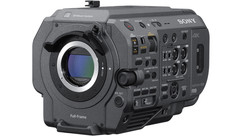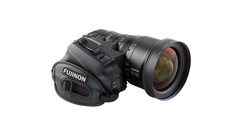Having previously owned the FS7, Rick was the perfect pro shooter to help us understand, from his point of view, how the new features fit into the types of projects a busy working professional undertakes. When brainstorming about a shooting scenario that would illuminate the most important enhancements, we settled on a hypothetical corporate interview setup (with gracious help from AbelCine’s own Director of Technical Development, Jesse Rosen). Rick describes these kinds of jobs as the owner-operator DP’s “bread and butter,” and we whole-heartedly agree.
5K Imager Scan Mode
To start off, we wanted to understand the limits of the new 5K recording mode as it relates to lens coverage with popular pro options. In this case, we chose Fujinon’s widely-owned and optically stellar Cabrio 19-90 T2.9 cinema zoom with integrated (but removable) servo as well as Cooke’s well-loved S4/i Super35 prime lenses. The Fujinon, with a roughly 3x zoom reach, typifies the kind of standard utility zoom that mated perfectly to popular large-sensor digital cinema cameras in the 2010s. While not capable of covering full-frame, the 19-90’s image circle does, at longer focal lengths, exceed the diagonal of 3-perf Super35. But where in the zoom range? And by how much? Likewise, for the Cooke lenses we tested, it’s long been known that longer focal lengths in the S4 line have more generous image circles but again the question was which ones? Take a look at the embedded video below to see the results of our testing.
As you can see, at a focal length and subject distance comfortable for interviews, the Fujinon Cabrio 19-90 provided interesting results. For the “low key” lighting setup as we had for this test, the FX9’s 4K sensor mode, as expected, showed no brightness fall-off in the corners at a setting of 50mm (near the center of the lens’ zoom range) and wide-open at a T-stop of 2.9.
In the FX9’s new 5K sensor mode, called “Imager Scan Mode” by Sony, things get interesting. This mode, introduced in firmware version 2.0, is a modest “crop” of the sensor at a little over 5K horizontally and covering roughly 83% of the camera’s 6K full-frame sensor (5008x2640 pixels, or 29.7mm x 15.7mm for a diagonal of 33.6mm). It should be noted that we were working with the conceit that, in many scenarios, some amount of brightness fall-off in the corners may be desirable, such as in the more stylized interview setups we often see or even in the business sphere, especially in technology. And when shooting a “baked-in look,” such as for delivery to clients who don’t have the time, budget or expertise for color grading in post, brightness fall-off in the corners can add a desirable stylistic element to the framing that can be difficult to achieve without more extensive post work (note: all footage in our tests was captured in the default ‘SDR’ shooting mode with S-Cinetone gamma unless otherwise noted — more on that mode and its significance below). The fall-off in the corners we observed with the Fujinon 19-90, at 5K on the FX9, was soft and gentle without any hard edges or abrupt transitions. However at 6K full-frame, we’ve clearly exceeded the lens’ image circle and are seeing “hard” vignetting (the shot was not reframed in order to show the effect).
The Cooke S4/i prime lenses we tested, 32mm and 50mm, also yielded interesting results. Both covered the standard Super35 4K sensor mode on the FX9, as expected, but when we moved to the 5K mode the 32mm showed hard vignetting in the corners while the 50mm showed almost none. Even at 6K full-frame on the FX9 we observed very clean corners with the 50mm S4/i.
"The key thing for me was that the Fujinon Super35 19-90mm zoom, that I own and have used since it came out in 2012, now has a new life over a larger sensor area, which was a revelation. This had me looking a little more deeply into concepts like image circle, sensor size, and ‘crop factor’. Having a sensor in the FX9 with these different, and flexible sensor modes can really help you understand field of view and how it relates to lens design in a new way. Very informative.
-Rick Siegel
When talking about lens coverage the upshot, as always, is: test, test, test! You never know what you might find, either good or “bad,” that might contribute to a unique look for your next project.
SDR & HDR Shooting Modes (or, What Happened to Custom Mode?)
With firmware 2.0, Sony split the Custom shooting mode, familiar to those who’ve worked with their FS7/FS7 II and F5/F55 cameras, into two dedicated modes: SDR and HDR. The SDR shooting mode is more or less the same as the old Custom mode on the earlier cameras. It allows for shooting a ‘what you see is what you get’ picture style with a variety of color, gamma, and detail settings exposed in the camera’s Paint menu to allow for fine matching between cameras or “tweaking” of the image to get a specific look that you or your clients may be after. This is also the mode designed to have AbelCine’s scene files for the FX9 applied.
One notable addition to this mode is a new gamma category, called "Original", which contains Sony’s S-Cinetone gamma, giving footage a cinematic feel in terms of color and contrast; it is the new default setting on the camera. The other familiar gamma categories are still present and the default on the earlier cameras, STD5 R709, is available for matching with other Sony bodies.
The new HDR mode is for those occasions when a project is being shot live and there isn’t time to create dedicated SDR and HDR versions of an event, such as in news, sports or music, but where a single file compatible with both SDR and HDR displays is needed. The FX9’s HDR mode uses the Hybrid Log-Gamma (also known as HLG) implementation of HDR created by the BBC and NHK for just this purpose. It’s exactly what it sounds like: a hybrid approach that uses a conventional gamma curve (similar to REC709) for picture information below middle gray and a Log-like curve above middle gray to maximize the HDR effect (expanded dynamic range with brilliant highlights) on compatible displays.
The above clip was mastered in HLG using the P3-D65 color space with metadata tagging and should engage the HLG picture mode on compatible displays. For environments without HLG support, an SDR-tagged version will be streamed.
Sony has created two basic presets for HDR mode on the FX9: Natural and Live. The Natural setting conforms to the ITU-R BT.2100 specification for HLG and the Live setting delivers improved HDR performance, with the caveat that more noise may appear in the image. A condensed Paint menu with adjustments for Black Offset and Knee (including point and slope) is available in HDR mode as well.
"My big takeaway from looking at these two new shooting modes was that what I (or we — those of us coming from previous Sony cameras) think of as ‘Custom’ mode is exactly what’s now called SDR mode on the FX9, plain and simple. If you used to shoot projects for clients in Custom mode on a different Sony camera, then SDR is the FX9 equivalent. As for the HDR mode, which is the Hybrid Log Gamma “flavor” of High Dynamic Range video, in addition to an expanded latitude, we noticed that the ‘Natural’ setting had a flatter look to it on the REC709 monitor we were using on set while shooting, and that the ‘Live’ setting had more punch and presence and overall seemed more ready-to-go for broadcast. I’ve not – yet – had any clients request this new format, but it’s nice to know the camera is ready for the future."
User 3D LUTs
Firmware 2.0 also saw the addition of User 3D LUTs added to the FX9. We selected a dramatic film look treatment created by Technicolor (available for download as part of Sony’s Technicolor Collection) and applied it to our monitoring signal paths while shooting in the camera’s Cine EI mode. This allowed us to pre-visualize the effect of one possible color grading look for our shots, by using the Technicolor look as our Monitoring LUT, while maintaining the pristine SLog-3/SGamut3.Cine file’s massive dynamic range and color space.
The LUT may also, optionally, be burned into the recording if a particular look is one that you want to commit to for the project. In the embedded clip above, you’ll first see the un-graded Log image, then a version with the LUT applied at full strength (which we felt was too heavy-handed), and finally an interpretation that uses the same LUT as a starting point however reduced in strength to 50% and with some additional grading applied.
"It’s great to see this feature from other Sony cameras implemented on the FX9. It’s good to know that you can create your own lookup table or, as we did, choose one from the new Sony Technicolor Collection. Many of these are based on discontinued film stocks or other processes from the film era and I’m really happy to have some of these ‘old paints’ to dip my ‘new brushes’ into."
Autofocus
The last ten years have seen autofocus for video move out of the shadows and into the mainstream for specific types of jobs. While still somewhat controversial, it can be a godsend for DPs and Directors acting in multiple capacities or small crews for some types of shoots, with interviews at the top of the list. The implementation of face detection, which has been present on the camera since its launch, and especially the new eye detection and tracking that debuted on the FX9 with firmware 2.x, is first-rate. As you’ll see in the clip below, the box tracking Jesse’s eye nearest the camera stayed essentially glued to him even during some frenetic movement, and only defaulted back to a larger area of focus tracking when his face was totally obscured. The update rate for the tracking never lagged and focus changes never looked stilted or mechanical. For this test we used Sony’s excellent FE 24-70mm f/2.8 GM autofocus zoom lens (at 70mm and wide open at f/2.8).
"For an interview, I will generally pull my own focus. However, especially on longer interviews, it can become fatiguing. The new eye detection feature acted as a tireless and accurate way to keep the subject in perfect focus so I could concentrate solely on operating, framing and composition. The eye detection was solid and fast; for situations where you’re working with shallow depth-of-field on a large sensor camera I actually think it’s a safer way to go."
We really appreciate Rick giving his time to help us take a deeper look into some of the new features in the 2.0 (now 2.1) firmware on the FX9. While we always enjoy working with new gear and firmware updates, nothing can replace the point-of-view of an experienced DP with many years of real-world, on-the-ground experience.













AbelCine encourages comments on our blog posts, as long as they are relevant and respectful in tone. To further professional dialog, we strongly encourage the use of real names. We reserve the right to remove any comments that violate our comment policy.
AbelCine publishes this blog as a free educational resource, and anyone may read the discussions posted here. However, if you want to join the conversation, please log in or register on our site.
We use Disqus to manage comments on this blog. If you already have a Disqus account registered under the same email as your AbelCine account, you will automatically be logged in when you sign in to our site. If not, please create a free account with Disqus using the same email as your AbelCine account.